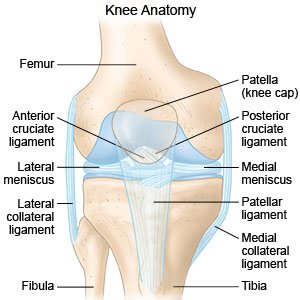Meniscectomy
Medically reviewed by Drugs.com. Last updated on Sep 23, 2025.
WHAT YOU NEED TO KNOW:
A meniscectomy is surgery to repair your meniscus, or remove any torn pieces. The meniscus is cartilage in your knee that acts like a shock absorber, and helps your knee move correctly.
 |
HOW TO PREPARE:
The week before your surgery:
- Arrange to have someone drive you home after surgery.
- Tell your surgeon about all the medicines you currently take. He or she will tell you if you need to stop any medicine before surgery, and when to stop. He or she will tell you which medicines to take or not take on the day of surgery.
- You may need to have blood tests, x-rays, or other tests before your surgery. Ask for more information about these and other tests you may need. Write down the correct date, time, and location of each test.
The night before your surgery:
You may be told not to eat or drink anything after midnight.
The day of your surgery:
- You or a close family member will be asked to sign a legal document called a consent form. It gives healthcare providers permission to do the procedure or surgery. It also explains the problems that may happen, and your choices. Make sure all your questions are answered before you sign this form.
- Take only the medicines your surgeon told you to take.
- An IV will be put into a vein. You may get medicine or liquids through the IV.
- An anesthesiologist will talk to you before your surgery. You may need medicine to keep you asleep or numb an area of your body during surgery. Tell healthcare providers if you or anyone in your family has had a problem with anesthesia in the past.
WHAT WILL HAPPEN:
What will happen:
- You may be given general anesthesia to keep you asleep and free from pain during surgery. You may instead be given spinal anesthesia to numb the surgery area. With spinal anesthesia, you may still feel pressure or pushing during surgery, but you should not feel any pain.
- Your surgeon will make one or more small incisions in your knee. You may instead have open knee surgery with one larger incision. Your surgeon will put an arthroscope inside your knee. An arthroscope is a thin tube with a camera on the tip. He or she will use the arthroscope and other small tools to look at and fix your meniscus.
- Your surgeon may repair your meniscus with stitches or a device. He or she may remove all or part of your meniscus. Your surgeon may transplant a piece of donor meniscus into your knee to replace what has been removed. He or she may also fix other damage to bones, ligaments, tendons, or tissue during your surgery. The incision will be closed with stitches, adhesive tape, or bandages.
After your surgery:
You will be taken to a room to rest until you are fully awake. A clean dressing and an elastic wrap bandage may cover your stitches. Healthcare providers will watch you closely for any problems. Do not get out of bed until your healthcare provider says it is okay. When healthcare providers see that you are ready, you may be allowed to go home. If you are staying in the hospital, you will be taken to your room.
CONTACT YOUR HEALTHCARE PROVIDER IF:
- You have a fever.
- You get a cold or the flu.
- You have a cut, redness, or a rash on or near your knee.
- You have questions or concerns about your surgery.
Risks
You may bleed more than expected or get an infection. Your knee tissue and cartilage may be damaged during surgery. If you have a meniscus transplant, your meniscus may tear, shrink, or move out of place. You may have continued pain or knee stiffness after surgery. You may develop joint disease, or the cartilage and bones in your knee may break down over time. You may need this surgery more than once, or you may need another type of knee surgery. You may get a blood clot in your leg. This may become life-threatening.
Care Agreement
Follow up with your doctor as directed:
Write down your questions so you remember to ask them during your visits.
© Copyright Merative 2025 Information is for End User's use only and may not be sold, redistributed or otherwise used for commercial purposes.
The above information is an educational aid only. It is not intended as medical advice for individual conditions or treatments. Talk to your doctor, nurse or pharmacist before following any medical regimen to see if it is safe and effective for you.
Further information
Always consult your healthcare provider to ensure the information displayed on this page applies to your personal circumstances.
